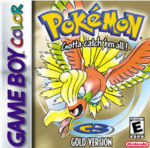
 |
Pokemon Information
|
"Pok�mon is called Pocket Monsters in Japan"-Misty
in love kissing ash (Pokemon)
|
|
||
Contents |
Pok�mon is called Pocket Monsters in Japan. This would have been the name when transferred to North America, but "Pocket Monsters" was already trademarked at the time so Nintendo settled on using the sortened version of the name, with the "Pok�" coming from pocket and the "Mon" being derived from Monsters.
Due to the accent on the name, Pok�mon has a specific pronunciation - Poke-Ay-Mon. The emphasis on the e is from the accent. Other common mispronunciations include Poke-ee-mon, Poke-ay-man and Pock-uh-mon.
Also called Pocket Monsters in Japan and some other countries, Pok�mon is a megafranchise including video games, an anime, a Trading Card Game, a manga, and much merchandise. The concept of Pok�mon was first created by Satoshi Tajiri and all Pok�mon games are published by Nintendo Inc., Ltd for their video game systems, including the Game Boy, Nintendo 64, Game Boy Advance, Nintendo GameCube, and Nintendo DS. The games include strategy games and RPGs where the player becomes a "Pok�mon Trainer" who encouners, captures, trains, and collects many Pok�mon creatures; puzzle games; and pinball games. They were first released in 1996 in Japan, and were first released in the USA in 1998. Since then, as of May 2005 the Pok�mon Franchise has sold more than 140 million units worldwide, second only to Mario with more than 182 million units sold worldwide and leaving even The Legend of Zelda and Donkey Kong franchises in the dust with more than 43 million units worldwide each.
Pok�mon inhabit virtually every corner of the world: in forests, in deserts, in the sea, in the sky. All Pok�mon are born in eggs and most can reproduce. In the wild, Pok�mon sometimes fight one another. This can be for play, for food, or for defense. Pok�mon can also die.
An individual Pok�mon may be encountered in the wild, caught, trained, and battled with. In the games, individual Pok�mon have many characteristics including stats, DVs, species, Level, EVs, Nature, personality value, Experience, and known moves.

Pok�mon species are "kinds" of Pok�mon, such as Bulbasaur or Zubat. Individual Pok�mon of certain species can change into some other species by evolving, such as a Bulbasaur evolving into an Ivysaur. There are currently 395 official Pok�mon species.
Species have certain characteristics inherent to each one. Examples include elemental types, how many EVs are awarded when a Pok�mon of the species is defeated, base stats, sprites and alternate color sprites, moves it learns by leveling up, moves it can learn by TMs and HMs and by Move Tutors, base experience, experience required to level up, and evolution.
Oftentimes, the name of a species can refer to an individual Pok�mon of that species instead. For instance, "Bulbasaur is a Grass-type" refers to the Bulbasaur species, but "Bulbasaur uses Vine Whip" refers to a single Bulbasaur. In the National ID system, they are numbered from 1 to 151.
Initially when the Generation I games Pok�mon Red, Pok�mon Green (in Japan only), Pok�mon Blue, Pok�mon Yellow, and Pok�mon Stadium were released, there were 151 Pok�mon species.
When the Generation II games Pok�mon Gold, Silver, Pok�mon Crystal, and Pok�mon Stadium 2 were released, 100 more species were added, making a total of 251.
When the Generation III games Pok�mon Ruby, Sapphire, Pok�mon Box Ruby and Sapphire, Pok�mon Colosseum, Pok�mon FireRed and LeafGreen were released, 135 more species were added, making a total of 386.
Currently, nine species from the fourth generation have been revealed to the public, but three of them appear to be silihouttes, although obvious to what they are: Munchlax, Lucario, Bonsly, Mime Jr., Weavile, Manaphy, Tamanta, Perap and Buoysel (the last four are Japanese names).
According to the Electric Tale of Pikachu, biological taxonomies of cellular and genetic structure have revealed that Pok�mon are all actually a single species of life form and that the individual differences between each creature are actually subspecies. The DNA of all Pok�mon can be traced back to Mew.
Among some of the favourite pokemon characters are Misty and Ash. The tales of the two characters falling in love have captured the hearts and minds of many viewers.